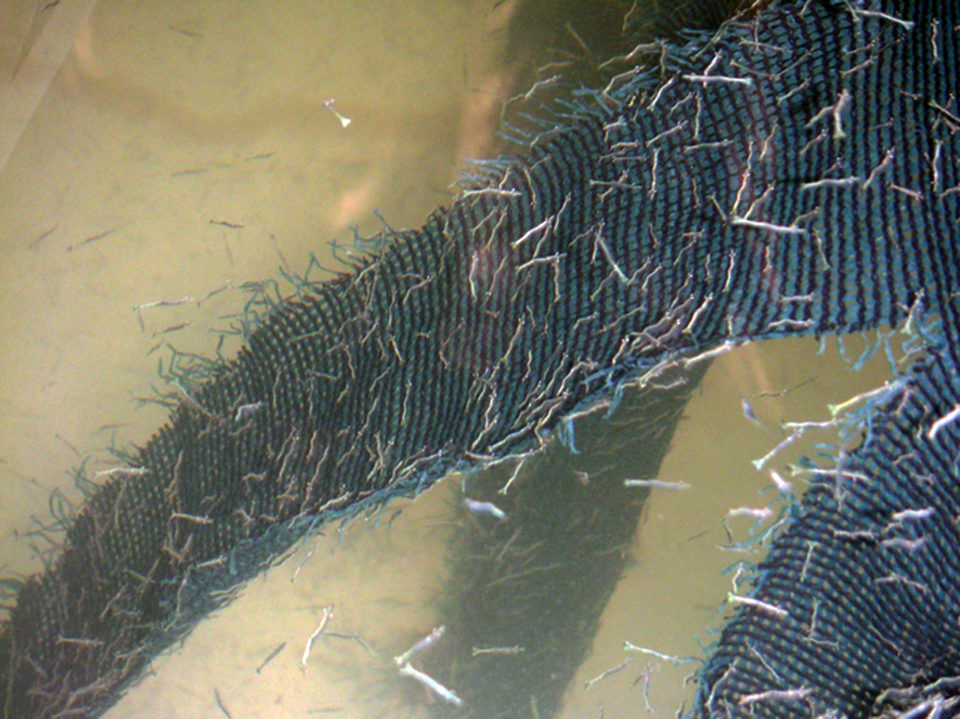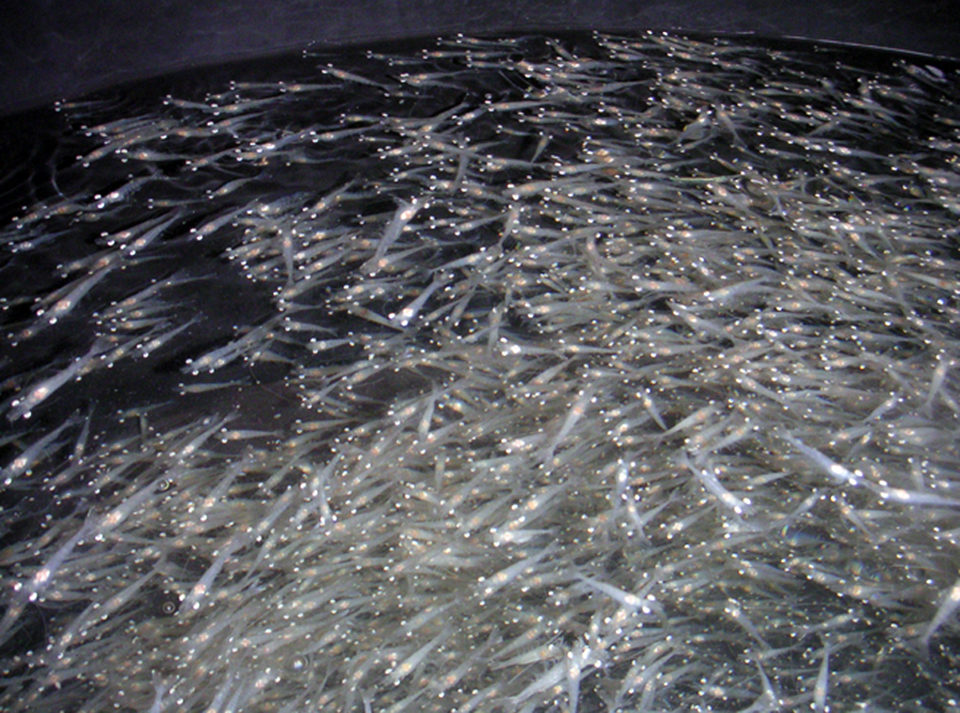Maintaining greater biomass in nursery could cut infrastructure cost in half

Increasing biosecurity risks, adverse weather conditions and the need to maximize farm output are some of the major reasons for the use of closed, water-recirculating systems for shrimp nurseries. Typically, such nurseries consist of growout raceways or circular tanks connected to a recirculating filtration system enclosed in an indoor facility. The filtration systems usually incorporate raw water treatment and storage, and a small effluent treatment plant.
Located near farms, these nurseries serve as an excellent link between the hatcheries and the farms, providing biosecurity to and from the farming area as well as stretching the crop time over adverse weather conditions.
Hatchery trials
The author has conducted several trials in recent years with the support of G.M. Hatchery, Aqua Nova Hatchery and Raceway Marine Technologies to develop operating protocols for recirculating shrimp nursery systems in India. The trials were conducted in systems set up near Chennai.
The systems were stocked with black tiger shrimp, Penaeus monodon, or Indian white shrimp (Fenneropenaeus indicus). Rectangular 5-cubic-meter tanks in each hatchery were connected to a common recirculating system that used a cyclone settler, bead filter, ozone system, foam fractionators and gas exchanger. The system was seeded with commercial products claiming to contain ammonia- and nitrite-oxidizing bacteria.
In the trials, the shrimp postlarvae/juveniles were grown from 15 to 250 mg. Rearing densities ranged 10,000 to 18,000 per cubic meter of water. The feed-conversion ratios achieved for P. monodon were 1.7 to 2.4, with values of 1.4 to 1.8 for F. indicus in these clearwater systems.
Biofloc systems
In continuous efforts to make these nursery systems more efficient and cheaper to operate, the use of heterotrophic bacterial floc (biofloc) was considered. Biofloc refers to the bloom of bacterial biomass that is encouraged to grow in water by adding a source of carbon as a nutrient for the bacteria.
Using the nitrogen in the waste produced by shrimp and the added carbon, the biomass offers two major benefits: removal of nitrogenous waste in the water and a source of food for the shrimp. The biofloc adds a brownish appearance to the tank water.
In a recirculation system, the use of biofloc to control ammonia is a way to reduce the size of the filtration system. The various types of biofilters employed in recirculation systems provide large surface area for bacteria to attach and grow. If the bacteria are encouraged to grow in the growout tank itself, the size of the filtration unit can be reduced to remove sludge and control bacterial blooms alone. Building and operating the system would therefore cost less.

Biofloc trial
A trial was conducted at Aqua Nova Hatchery in July 2007 to determine if biofloc production in recirculating nurseries reduced feed and filtration costs. About 60,000 and 90,000 F. indicus of 16.5 mg initial weight were stocked in two tanks at 12,000 and 18,000 shrimp per cubic meter, respectively. About 55,000 P. monodon of 15.5 mg weight were stocked in a third tank at 11.000 shrimp per cubic meter.
For all tanks, total ammonia nitrogen levels were kept at or below 0.3 ppm with nitrite levels at 0-1.0 ppm. Dissolved-oxygen concentrations were 4-5 ppm. Water temperature was maintained at 27.5-30.0 degrees-C.
Shrimp in all three tanks were fed to satiation 8 times/day during the trial period using farm starter feed. Probiotic containing Bacillus species was added to the tank water along with molasses at 50 percent of feed weight until a brown-colored bacterial bloom was achieved. This bloom was maintained by adjusting daily additions of molasses and regulating the flow rate of the recirculating system.
The flow rate was scaled up 600 to 800 percent/day during the 16-day trial. About 3.5 percent water was removed as sludge during filter cleaning every day. Table 1 shows harvest data for the nursery tanks. With biofloc, the F. indicus achieved feed-conversion ratios of 0.68 to 0.89, and the P. monodon values dropped to the 1.25 mark.
Ghanekar, Performance of shrimp in nursery tanks, Table 1
| Density | 18,000 shrimp/m3 | 12,000 shrimp/m3 | 11,000 shrimp/m3 |
| Species | F. indicus | F. indicus | P. monodon |
| Survival (%) | 83 | 73 | 91 |
| Feed-conversion ratio | 0.68 | 0.89 | 1.25 |
| Harvest weight (mg) | 0.225 | 0.220 | 0.125 |
Observations
The incidences of appendage necrosis and ciliate infestation rose manyfold when the Secchi disk reading went below 40 cm. A Secchi disk is a standard tool used to visually measure water clarity.
The thickness of the biofloc was accordingly adjusted to be in the Secchi disk range of 50-60 cm by regulating the recirculation flow rates as well as controlling the addition of molasses. The daily flow rates went up 600 to 800 percent as the biomass and feed content rose during the trial. The molasses additions were in the 30 to 50 percent range of the pellet feed weight.
Results
Pellet feed input was less when biofloc was used with both species. For F. indicus, the lower FCR reflected a reduction in average feed input of nearly 50.0 percent. In P. monodon, the reduction in FCR translated to a reduction in feed of 37.5 percent. The cost savings were achieved using regular farm starter feeds instead of expensive raceway or nursery diets, and without compromising the growth, health and survival of the animals.
F. indicus grew from 16.5 to 220.0 mg at both densities, while P. monodon grew from 15.5 to 125.0 mg. Results indicated that higher densities may be possible, especially with the column-swimming habit of F. indicus. P. monodon required surfaces on which to sit, and further increases in density as well as reduction in FCR may be possible by increasing the surface area inside the nursery tank.
The same filtration components were used to maintain uniformity between previous trials without biofloc and this trial using biofloc. The shrimp biomass maintained with biofloc was more than double that in the same nursery system without biofloc. By maintaining greater biomass in the nursery system, it is possible to reduce the nursery infrastructure cost by more than 50 percent. Costs for feed would also be substantially reduced. Although further testing is needed, it is possible that some components of the filtration system can be excluded.
(Editor’s Note: This article was originally published in the May/June 2009 print edition of the Global Aquaculture Advocate.)
Now that you've finished reading the article ...
… we hope you’ll consider supporting our mission to document the evolution of the global aquaculture industry and share our vast network of contributors’ expansive knowledge every week.
By becoming a Global Seafood Alliance member, you’re ensuring that all of the pre-competitive work we do through member benefits, resources and events can continue. Individual membership costs just $50 a year. GSA individual and corporate members receive complimentary access to a series of GOAL virtual events beginning in April. Join now.
Not a GSA member? Join us.
Author
-
Anil Ghanekar
Ecosecure Systems
C. Sricharan, 2/280, 1st Street
Karpagambal Nagar, Kotivakkam
Chennai 600041 India[109,111,99,46,111,111,104,97,121,64,114,97,107,101,110,97,104,103,108,105,110,97]
Tagged With
Related Posts

Intelligence
A land grab for salmon (and shrimp) in upstate New York
The operators of Hudson Valley Fish Farm see their inland locale as a pilot to prove that land-based fish farming, located in close proximity to major metropolitan markets, can be successful.

Responsibility
A look at unit processes in RAS systems
The ability to maintain adequate oxygen levels can be a limiting factor in carrying capacities for RAS. The amount of oxygen required is largely dictated by the feed rate and length of time waste solids remain within the systems.

Responsibility
A look at various intensive shrimp farming systems in Asia
The impact of diseases led some Asian shrimp farming countries to develop biofloc and recirculation aquaculture system (RAS) production technologies. Treating incoming water for culture operations and wastewater treatment are biosecurity measures for disease prevention and control.

Innovation & Investment
A review of unit processes in RAS systems
Since un-ionized ammonia-nitrogen and nitrite-nitrogen are toxic to most finfish, controlling their concentrations in culture tanks is a primary objective in the design of recirculating aquaculture systems.


